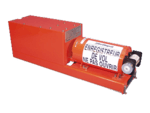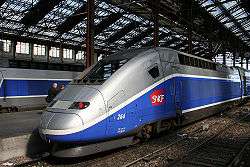Transportation Safety Board of Canada
| Bureau de la sécurité des transports du Canada | |
|
TSB-BST logo | |
|
Place du Centre, the headquarters of the TSB | |
| Agency overview | |
|---|---|
| Formed | March 29, 1990 |
| Preceding agency |
|
| Jurisdiction | Government of Canada |
| Headquarters | Gatineau, Quebec |
| Employees | 220 |
| Agency executive |
|
| Website | Transportation Safety Board website |
The Transportation Safety Board of Canada (TSB, French: Bureau de la sécurité des transports du Canada, BST), officially the Canadian Transportation Accident Investigation and Safety Board (French: Bureau canadien d’enquête sur les accidents de transport et de la sécurité des transports)[1] is the agency of the Government of Canada responsible for advancing transportation safety in Canada. The independent agency investigates accidents and makes safety recommendations in four modes of transportation: aviation, rail, marine and pipelines.
Agency history
Prior to 1990, Transport Canada's Aircraft Accident Investigation Branch (1960-1984) and Canadian Aviation Safety Board or CASB (1984-1990) was responsible for investigation of air incidents.[2] Before 1990, investigation and actions were taken by Transport Canada and even after 1984 the findings from CASB were not binding for Transport Canada to respond to.[2]
The TSB was created under the Canadian Transportation Accident Investigation and Safety Board Act, which was enacted on March 29, 1990. It was formed in response to a number of high-profile accidents, following which the Government of Canada identified the need for an independent, multi-modal investigation agency. The headquarters are located in Place du Centre in Gatineau, Quebec.
The provisions of the Canadian Transportation Accident Investigation and Safety Board Act were written to establish an independent relationship between the Board and the Government of Canada. This agency's first major test came with the crash of Swissair 111, on September 2, 1998, the largest single aviation accident on Canadian territory since the Arrow Air disaster. The TSB delivered its report on the accident on March 27, 2003, some 4½ years after the accident and at a cost of $57 million CAD, making it the most complex and costly accident investigation in Canadian history.
The Board is composed of 4 members:[3]
- Chair Kathleen Fox
- Member Faye Ackermans
- Member John Clarkson
- Member Hélène Gosselin
- Member Joseph Hincke
The Transportation Safety Board's mandate is to:
- conduct independent investigations, including public inquiries when necessary, into selected transportation occurrences in order to make findings as to their causes and contributing factors;
- identify safety deficiencies, as evidenced by transportation occurrences;
- make recommendations designed to eliminate or reduce any such safety deficiencies; and
- report publicly on their investigations and on the related findings
The TSB may assist other transportation safety boards in their investigations. This may happen when:
- an incident or accident occurs involving a Canadian-registered aircraft in commercial or air transport use;
- an incident or accident occurs involving a Canadian-built aircraft (or an aircraft with Canadian-built engines, propellers, or other vital components) in commercial or air transport use;
- a country without the technical ability to conduct a full investigation asks for the TSB's assistance (especially in the field of reading and analyzing the content of flight data recorders and cockpit voice recorders).
TSB statistics report that Air, Rail, and Marine accident rates have been fairly steady over the past five years (2001–2006). (Pipeline accidents are not common enough for statistics to be relevant.) Traffic on the three major modes of transport has risen about 5% in the meantime. In the fiscal year 2005–2006, there were over 4,000 transportation "occurrences" reported in Canada. Most of these were minor incidents, involving only property damage, but major fatal accidents are also included in this total. In the same year, 79 accidents and incidents required TSB investigation.
Provincial and territorial governments may call upon the TSB to investigate occurrences. However, it is up to the TSB whether or not to proceed with an investigation. Public reports are published following class one, two, three and four investigations. Recommendations made by the TSB are not legally binding upon the Government of Canada, nor any Ministers of Departments. However, when a recommendation is made to a federal department, a formal response must be presented to the TSB within 90 days.
In recent years, the TSB has concluded a number of high profile investigations, including Air France (A05H0002), the Cheakamus River (R05V0141), the Queen of the North (M06W0052), Picton Castle (M06F0024), the Burnaby pipeline rupture (P07H0040), Cougar Helicopters (A09A0016), the Concordia (M10F003).To increase the uptake of its recommendations and address accident patterns, the TSB launched its Watchlist in 2010, which points to nine critical safety issues troubling Canada’s transportation system.
On 3 December 2013, in the wake of the Lac-Megantic rail disaster it was reported that the number of runaway trains was triple the number documented by Transportation Safety Board.[4]
In August 2014, the TSB released their report on their investigation into the July 2013 Lac-Megantic derailment.[5][6] In a news conference, TSB chair Wendy Tadros described how eighteen factors played a role in the disaster including a "weak safety culture" at the now-defunct Montreal, Maine & Atlantic Railways with "a lack of standards, poor training and easily punctured tanks." The TSB also blamed the Transport Canada, the regulator, for not doing thorough safety audits often enough on railways "to know how those companies were really managing, or not managing, risk."[5] The TSB report called for "physical restraints, such as wheel chocks, for parked trains." Prior to the accident TSB had called for "new and more robust wagons for flammable liquids" but as of August 2014, little progress had been made in implementing this.[6]
The TSB reports to the Parliament of Canada through the President of the Queen’s Privy Council.
List of Chairs
- John W. Stants 1990 - 1996
- Benoît Bouchard 1996 - 2001
- Camille Thériault 2001 - 2002
- Charles H. Simpson 2002 - 2005 (acting)
- Wendy A. Tadros 2005 - 2006 (acting)
- Wendy A. Tadros 2006 – 2014
- Kathleen Fox 2014 – present
See also
References
- ↑ "About the TSB". Transportation Safety Board of Canada. October 6, 2014.
- 1 2 http://www.wingsmagazine.com/content/view/3377/60/
- ↑ "Transportation Safety Board : The Board". tsb.gc.ca. 2012. Retrieved August 19, 2012.
- ↑ cbc.ca: "Runaway trains almost triple reported rate, CBC finds", 3 Dec 2013
- 1 2 "Investigators Release Quebec Train Disaster Report", AP, Toronto, Ontario: New York Times, 19 August 2014, retrieved 30 August 2014
- 1 2 "Oil in Canada: Crude errors", The Economist, 23 August 2014, retrieved 30 August 2014
External links
- Transportation Safety Board website (English) / (French)


